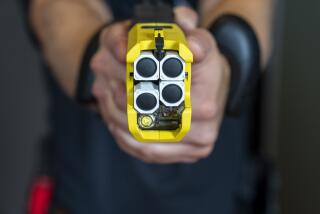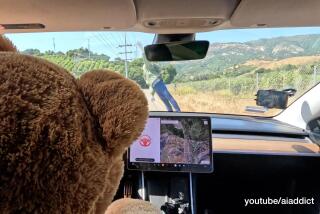Testing, Testing : Facility in Fullerton Measures Worthiness of Hundreds of Products
The “airplane seat of the future” won’t fly if it can’t withstand a few shakes.
So, for the past several weeks, the seat has been hooked up to an Electro Vibration Exciter at National Technical Systems, which is putting the seat through high-voltage shaking to determine its durability.
Vibration is one of NTS’s easier trials. NTS’s Technical Services Division in Fullerton subjects products to hundreds of tests, which often take place in sealed vaults, that can measure everything from a product’s sea-worthiness to its resistance to fungus.
And NTS will test almost anything.
“If it can be tested, we’ll do it. You want to see how strong your shoes are? We’ll test them . . . no questions asked,” said Vice President Richard Short, NTS’s chief tester.
NTS bought the Fullerton lab in 1975, but the facility has been a testing site since the late 1950s. In the early days, the lab, known as United Testing Laboratory, profited from the burgeoning space industry by testing fuel tanks and other products bound for space and moon flights.
By the time NTS bought the lab, the company had diversified beyond space programs by conducting tests on defense products and cars, including a speed test of an Italian car that carried a Ford engine.
Since then, home pregnancy kits, missile components, football helmets and hundreds of other products have been tested. Short said NTS will test everything except liquids, “which get too messy.”
Revenues for the technical division reached a record $21.9 million for fiscal 1988, which ended Jan. 31, an increase of 34% over a year earlier. The technical division is the largest part of NTS, which is headquartered in Calabasas and also operates an engineering services division. Fiscal 1988 revenues for all of NTS operations were a record $29 million, up 36% from a year ago.
Technical division sales were boosted in part by increased tests of rocket boosters for the space shuttle program. In addition, Short said, manufacturers are more safety-conscious than ever and therefore demand more testing.
NTS’s competitors also have been profitable. “Testing facilities do a lot of work for the space shuttle. After the crash, nothing was done. Now it has recovered, and we have too,” said Van Holland, a vice president of Wyle Laboratories in Los Angeles.
While the technical division has been consistently profitable, NTS reported a loss of $1.7 million for fiscal 1987, when it halted its development of laser protective eye wear for the U.S. military. NTS’s annual report acknowledges that the technology used by a research division had become obsolete.
Earlier this year, the technical division bought a testing facility in Detroit with the hope of attracting more business from auto makers. Short expects the facility to conduct tests of car aging, vibration, fatigue and corrosion. The Technical Services Division also has test operations in Massachusetts, Virginia, Los Angeles and Saugus.
Most of the division’s largest customers--auto makers, military contractors, aerospace manufacturers and electronics firms--have internal testing facilities. But Short said they come to NTS because manufacturers’ internal operations often are backlogged with work.
“We’re quick, we have a lot of equipment and we are also absolutely objective,” Short said.
NTS has gained an impressive customer roster that includes the National Aeronautics and Space Administration, the National Highway Traffic Safety Administration and Aerojet Tech Systems.
“Over the years, they have consistently been a low bidder, and they have always been qualified contractors. They’re good people,” said Tom Grubbs of the National Highway Traffic Safety Administration, which has awarded auto collision contracts to NTS for more than 15 years.
Most testers are engineers and scientists. Dick Short, who started work at the Fullerton facility in 1961 while still in college, considers himself a childhood tinkerer grown up. At NTS in Fullerton, the playground for the tinkerers is a sprawling laboratory with millions of dollars worth of high-tech testing equipment.
“Since I was a kid, I’ve always liked to toy with devices, create problems and solve them. That’s exactly what I’m doing now,” said Dave Gregory, who is in charge of NTS’s Structural Dynamics Laboratory.
Gregory joined NTS in 1982 when he left a job in the testing division of General Motors in Michigan. “Cars got boring every day. Here, one week I’ll work on aerospace, another in the nuclear field and then maybe cars.”
One of Gregory’s favorite problem-solving challenges came from a missile maker whose product was missing its target. The failure was traced to a small component. To determine the cause of the failure, Gregory hooked the component to a computer, then duplicated the stimulus of a launch-firing by striking the component with a small hammer.
The component was unable to withstand the frequency of the firing, and NTS told the manufacturer how to redesign the part.
Tests often take weeks to prepare for, and then weeks to study the results.
For instance, NTS has been working with Aerojet Tech Systems in Sacramento for 15 months to study the rocket propulsion systems of engine components for the Titan missile.
“You don’t rush this work,” said Bill Huffman, an Aerojet project engineer who lives in Sacramento but has spent the last 15 months in Fullerton working with NTS engineers.
NTS’s car-collision tests also take months of work and patience to complete.
The crash takes an instant, but deciphering collision results is the hard part. NTS films each crash using 15 cameras, including three cameras below the ground that photograph the bottom of the car.
The tests might measure passenger head injuries, windshield strength or gas tank durability.
“To outsiders, watching the car crash might seem like the most fun. But to us, the fun part is the study afterward. It’s all science and math,” said project engineer Don Hand, who has worked at NTS since the company’s start 20 years ago. Before that he worked for an auto maker in its marketing department.
While most NTS tests are highly scientific, one part of the airplane seat study is designed to be subjective.
For the test, the seat manufacturer asked NTS to determine the effect of prolonged vibration not only on the seat, but also on a someone sitting in it. So NTS employees have taken turns as passengers.
“It’s a role-reversal. It adds a little more excitement,” Short said. “It’s that kind of excitement that makes it tough for people to ever leave.”
He said that of NTS’s 40 employees in Fullerton, nearly 20 of them have been with the company for at least 15 years.
And few testers retire. “They might say they’ve retired,” Short said. “But they get tired of testing things at home, so they come back in.”
More to Read
Inside the business of entertainment
The Wide Shot brings you news, analysis and insights on everything from streaming wars to production — and what it all means for the future.
You may occasionally receive promotional content from the Los Angeles Times.










